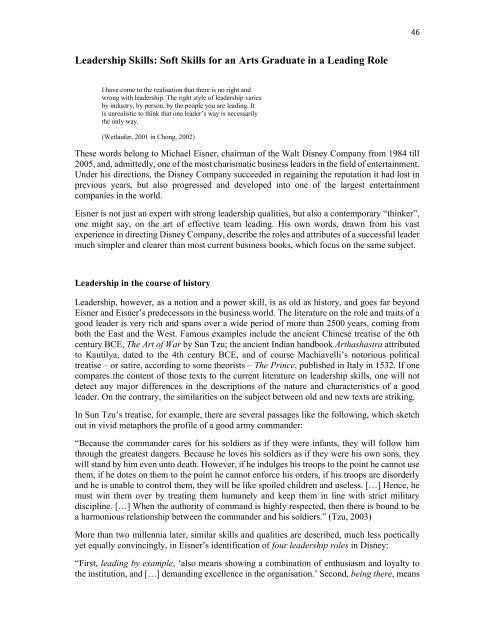and Music
Omega-Book
Omega-Book
You also want an ePaper? Increase the reach of your titles
YUMPU automatically turns print PDFs into web optimized ePapers that Google loves.
46<br />
Leadership Skills: Soft Skills for an Arts Graduate in a Leading Role<br />
I have come to the realisation that there is no right <strong>and</strong><br />
wrong with leadership. The right style of leadership varies<br />
by industry, by person, by the people you are leading. It<br />
is unrealistic to think that one leader’s way is necessarily<br />
the only way.<br />
(Wetlaufer, 2001 in Chong, 2002)<br />
These words belong to Michael Eisner, chairman of the Walt Disney Company from 1984 till<br />
2005, <strong>and</strong>, admittedly, one of the most charismatic business leaders in the field of entertainment.<br />
Under his directions, the Disney Company succeeded in regaining the reputation it had lost in<br />
previous years, but also progressed <strong>and</strong> developed into one of the largest entertainment<br />
companies in the world.<br />
Eisner is not just an expert with strong leadership qualities, but also a contemporary “thinker”,<br />
one might say, on the art of effective team leading. His own words, drawn from his vast<br />
experience in directing Disney Company, describe the roles <strong>and</strong> attributes of a successful leader<br />
much simpler <strong>and</strong> clearer than most current business books, which focus on the same subject.<br />
Leadership in the course of history<br />
Leadership, however, as a notion <strong>and</strong> a power skill, is as old as history, <strong>and</strong> goes far beyond<br />
Eisner <strong>and</strong> Eisner’s predecessors in the business world. The literature on the role <strong>and</strong> traits of a<br />
good leader is very rich <strong>and</strong> spans over a wide period of more than 2500 years, coming from<br />
both the East <strong>and</strong> the West. Famous examples include the ancient Chinese treatise of the 6th<br />
century BCE, The Art of War by Sun Tzu; the ancient Indian h<strong>and</strong>book Arthashastra attributed<br />
to Kautilya, dated to the 4th century BCE, <strong>and</strong> of course Machiavelli’s notorious political<br />
treatise – or satire, according to some theorists – The Prince, published in Italy in 1532. If one<br />
compares the content of those texts to the current literature on leadership skills, one will not<br />
detect any major differences in the descriptions of the nature <strong>and</strong> characteristics of a good<br />
leader. On the contrary, the similarities on the subject between old <strong>and</strong> new texts are striking.<br />
In Sun Tzu’s treatise, for example, there are several passages like the following, which sketch<br />
out in vivid metaphors the profile of a good army comm<strong>and</strong>er:<br />
“Because the comm<strong>and</strong>er cares for his soldiers as if they were infants, they will follow him<br />
through the greatest dangers. Because he loves his soldiers as if they were his own sons, they<br />
will st<strong>and</strong> by him even unto death. However, if he indulges his troops to the point he cannot use<br />
them, if he dotes on them to the point he cannot enforce his orders, if his troops are disorderly<br />
<strong>and</strong> he is unable to control them, they will be like spoiled children <strong>and</strong> useless. […] Hence, he<br />
must win them over by treating them humanely <strong>and</strong> keep them in line with strict military<br />
discipline. […] When the authority of comm<strong>and</strong> is highly respected, then there is bound to be<br />
a harmonious relationship between the comm<strong>and</strong>er <strong>and</strong> his soldiers.” (Tzu, 2003)<br />
More than two millennia later, similar skills <strong>and</strong> qualities are described, much less poetically<br />
yet equally convincingly, in Eisner’s identification of four leadership roles in Disney:<br />
“First, leading by example, ‘also means showing a combination of enthusiasm <strong>and</strong> loyalty to<br />
the institution, <strong>and</strong> […] dem<strong>and</strong>ing excellence in the organisation.’ Second, being there, means


